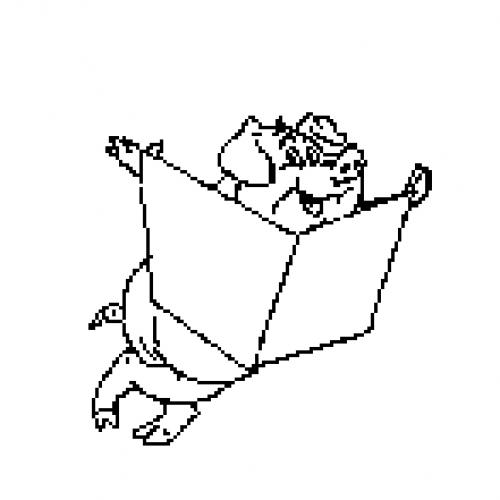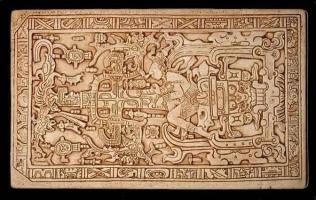Copy Link
Add to Bookmark
Report
Pig Genome Newsletter #025

PIG GENOME UPDATE No. 25
July 1, 1997
New pig genome database goes live. The new generic single species database
(Arkdb) developed by the Bioinformatics group at the Roslin Institute
(Archibald et al., 1996. Animal Genetics 27, Suppl 2. 55) has been
implemented for pig genome mapping data (and chickens and sheep). At
present the Arkdb version of PiGBASE is only mounted on the Roslin
Institute genome server
[URL = http://www.ri.bbsrc.ac.uk/ pigmap/ pigbase/pigbase.html] or
[URL = http://www.ri.bbsrc.ac.uk/cgi-bin/arkdb/browsers/browser.sh?species=pig].
It is planned that a mirror copy of the database will be mounted at one or
more sites in North America - beginning with Iowa State. Meanwhile, there
are of course links to PiGBASE from the US pig genome coordinator's page
[URL = http://www.public.iastate.edu/~pigmap/pigmap.html]. Editorial
responsibility for the new pig genome database will continue to be shared
by Alan Archibald (Roslin Institute) and Max Rothschild (Iowa State
University). The hard work of data entry and curation is undertaken by
Alison Brown (Roslin) and Lizhen Wang (Iowa). There is no requirement to
download additional software in order to view the maps associated with the
database. All you need for access is a WWW browser. As we are developing
new features with Java, it is worth using the latest versions of the
browsers that can handle Java. Some brief hints on using the new database
have been posted on the Angenmap news group. There is also on-line help,
especially for the Anubis map viewer software (Mungall, C. 1996.
Visualisation tools for genome mapping - the Anubis map manager. Animal
Genetics 27, Suppl. 2. 56; URL = http://www.ri.bbsrc.ac.uk/anubis/). The
loading of the new data types is progressing well. For example, details of
primer sequences, PCR conditions, sources of probes and libraries have been
entered for all the papers currently recorded in the database. Links have
been established to the DNA sequence databases where appropriate. It is
anticipated that further links from within PiGBASE to other databases will
be added. The most recent comprehensive linkage maps from the USDA-MARC
group and the Nordic collaboration have been entered. (Kindly provided on
behalf of the Roslin Institute's animal genome database group by Alan
Archibald).
Several of the genome coordinators met recently with advisors Dick Frahm
and Colin Scanes in Madison, Wisconsin. Issues discussed included the
development and upgrading of sites for nodes for the genome databases and
plans for the NRSP-8 renewal. Progress on the NRSP-8 renewal continues to
be made. Several writing committees have completed their portion of the
new draft. The renewal will now include Pigs, Cattle, Sheep, Poultry and
Horses. The renewal rewrite efforts are headed by Jerry Dodgson. The
coordinators also attended the retirement celebration for Neal Jorgensen.
Neal was extremely involved in the development of NRSP-8 and played a
significant role in getting it funded. The coordinators, on behalf of the
U.S. Animal Genome Community, presented Neal with a plaque honoring his
involvement. Plans to honor Neal at PAG VI are being made (see travel to
PAGVI).
The National Animal Genome Research Program was recently recognized by
receiving a USDA Honor Award. This is a significant award and the team of
Dick Frahm and the genome coordinators were recognized under the group
category for "Personal and Professional Excellence". The citation read
"for development and implementation of the first structured National Animal
Genome Research Program in the United States." The award was presented by
USDA Secretary Dan Glickman to team leader Dick Frahm and recognized also
at a separate ceremony held by CSREES. The team especially thanks all the
scientists in NRSP-8 for their efforts and cooperation.
PAG VI is shaping up nicely and it's not too early to start planning for
the PAGVI meeting in San Diego. The Plant and Animal Genome VI will be
January 18-22, 1998 and again will be in San Diego. The organizing
committee is already well along in planning next year's PAGVI. Ideas for
workshops and speakers can be directed to any of the planning committee
(Daniel Pomp, Jay Hetzel, Hans Cheng and Max Rothschild). Next year's
meeting will run in similar fashion with the probable addition of new
species groups and a meeting with industry representatives as a mechanism
to obtain more input and advice from them. Hotel accomodations for PAG-VI
next January will be limited by the Superbowl following us into San Diego
on the weekend after the meeting. Those who wish to attend PAGVI will need
to get their application forms in promptly. These will be distributed
later in the year. Travel assistance from Pig Genome Coordination funds
will again be available to help those individuals who need it. There will
be a Neal Jorgensen Animal Genome Travel Award for a Pig Genome graduate
student to attend the meeting. If you missed PAGV, you can find the
abstracts and other information at:
http://probe.nalusda.gov:8000/otherdocs/pg/pg5/allabstracts.html.
The Fifth International Congress on Pig Reproduction met in Rolduc, the
Netherlands. This meeting is every 4 years and features advances in male
and female pig reproduction. Over 180 scientists attended the 3 day
meeting. A total of 22 talks were given and over 70 posters dealing with
regulation of reproductive efficiency, factors affecting breeding
efficiency, embryonic and fetal development, boar fertility and semen
preservation, advances in biotechnology in pig reproduction including gene
mapping and aspects of oocyte and embryonic development were presented.
The proceedings will be published in book form later this year by the
Journal of Reproduction and Fertility.
The International Conference on Animal Biotechnology held in Beijing,
China, June 10-14, 1997 was particularly interesting from a pork industry
perspective since China produces 425 million of the world's 900 million
head of swine produced annually. Since 1987, China has mounted a concerted
effort to catch up to the West in biotechnology with projects including
transgenic pigs, recombinant vaccines, transgenic fish, and others. Still,
China's investment in biotechnology is low compared to other countries.
Access to livestock at the China Agricultural University in Beijing is
limited and laboratory facilities are outdated and crowded. Considering
these conditions and level of investment, the faculty and students of
animal biotechnology (totaling approximately 500 people at several
locations) in China are impressive. China also started an effort in
researching the human genome in 1994 with its 56 nationalities totaling 22
percent of the world's population. Here again, funding is lower than in
Europe, Japan, and the U. S., but information from this work will
significantly enhance efforts in livestock research. This conference was
attended by more than 150 scientists from some 20 countries and brought
together some of the top researchers from the two major fields of animal
biotechnology, gene mapping and transgenics. It featured a presentation by
Keith Campbell of Edinburgh on the cloning of the first adult mammal (Dolly
the sheep) and a presentation by Emanuele Cozzi from England on genetic
engineering of pigs to provide organs for human transplantation. There
were a number of presentations of information significant for the pig
industry among the 46 papers presented. David Meeker of the U. S. spoke on
the practical implications of biotechnology for the commercial pork
industry. Ariel Darvasi of Israel (now of
Jackson Labs in Maine) presented information on the use of selective
genotyping and selective phenotyping for QTL mapping which could be
particularly helpful to pig gene mapping efforts with smaller budgets.
Patrick Chardon of France spoke on the swine SLA Class I region. Hein van
der Steen of PIC in the UK spoke on a new genetic marker for litter size in
Meishan pigs. Ning Li of China spoke on a candidate gene approach for the
identification of genetic loci controlling litter size in pigs. Craig
Beattie of the U. S. presented information on the human genome project and
its implications for livestock biotechnology and health. Michele Mouricout
of France presented an research approach to developing genetic disease
resistance in pigs. Torsten Hardge of Germany spoke on the use of
association analysis of candidate genes for economically important traits
in extreme phenotypes of commercial pig breeds. Robert Wall of the U. S.
gave a keynote presentation of the progress and future prospects for
transgenic livestock. (Kindly provided by David L. Meeker)
It is not too late to plan to go to Armidale. The 6th World Congress on
Quantitative Genetics Applied to Livestock meets January 10-16 in Armidale,
Australia. Gene mapping and QTL sessions are planned. Abstracts are due
July 11, 1997.
Differential Display PCR (dd-PCR) is a powerful method for elucidating
differences and/or changes in gene expression between animals with
divergent phenotypes. This primer set consists of 10 oligo-dT anchor
antisense primers with different 2-base extensions on the 3' end, and 20
arbitrary 10-mer sense primers (5'), yielding a total of 200 primer
combinations for screening cDNA populations. Each anchor primer has T7
sequence on the 5' end, while each arbitrary primer has M13 sequence on the
5' end. These extensions allow for simplified reamplification, sequencing,
and expression studies of bands of interest. The set was put together by
Daniel Pomp and are available for distribution. Given the
more limited production of these primers, priority for distribution will be
NC-210 members and pig gene researchers. If interested, please request
primers from the Pig Genome Coordinator at mfrothsc@iastate.edu.
A third set of fluorescently labeled primers for pig microsatellites is now
being compiled. Funds for these materials are provided by the USDA-CSREES
Pig Genome Coordination Project. Suggestions to produce additional primer
pairs are still welcome.
Upcoming meetings:
Transgenic Animals in Agriculture, Granlibakken Conference Center, Tahoe
City, CA, August 24-27, 1997; see
http://pubweb.ucdavis.edu/Documents/BIOTECH/biotech1.htm.
International Course in QTL Detection and Marker-Assisted Selection, Mitzpa
Rachel Convention Center, Jerusalem, Israel, August 24-Sept. 4, 1997 (dates
tentative). Contact: Joel Weller at weller@agri.huji.ac.il.
6th World Congress on Genetics Applied to Livestock Production, Armidale,
New South Wales, Australia, January 12-16, 1998. Contact: Dr. Laurie Piper
at 61 67 73-3609, Fax: 61 67 73-3611,
email: 6wcgalp@mendel.une.edu.au.
PAGVI, January 18-22, San Diego CA.
Contributions to Pig Genome Update 26 including short meeting announcements
are always welcome. Please send by August 10.
Max F. Rothschild
U.S. Pig Genome Coordinator
225 Kildee Hall, Department of Animal Science
Iowa State University
Ames, Iowa 50011
Phone: 515-294-6202, Fax: 515-294-2401
mfrothsc@iastate.edu
cc: Dick Frahm, CSREES and Roger Gerrits, ARS
Paid for by funds from the NRSP-8 USDA/CSREES
sponsored Pig Genome Coordination Program.




















